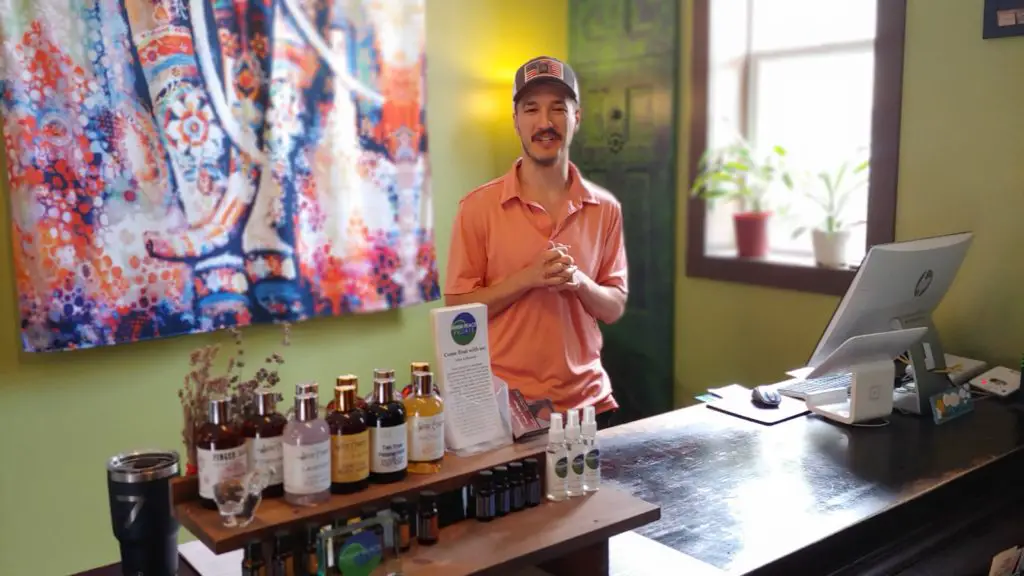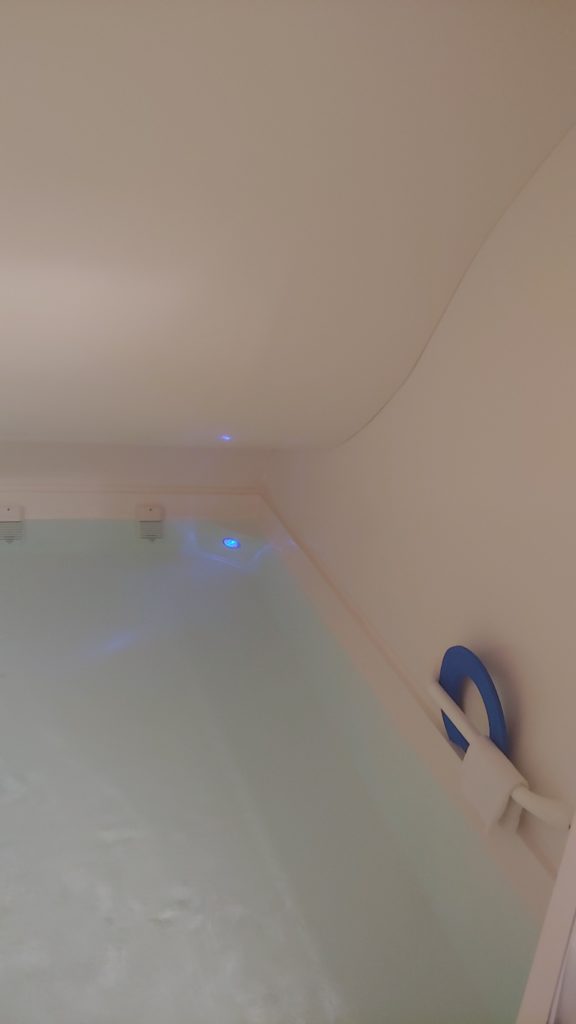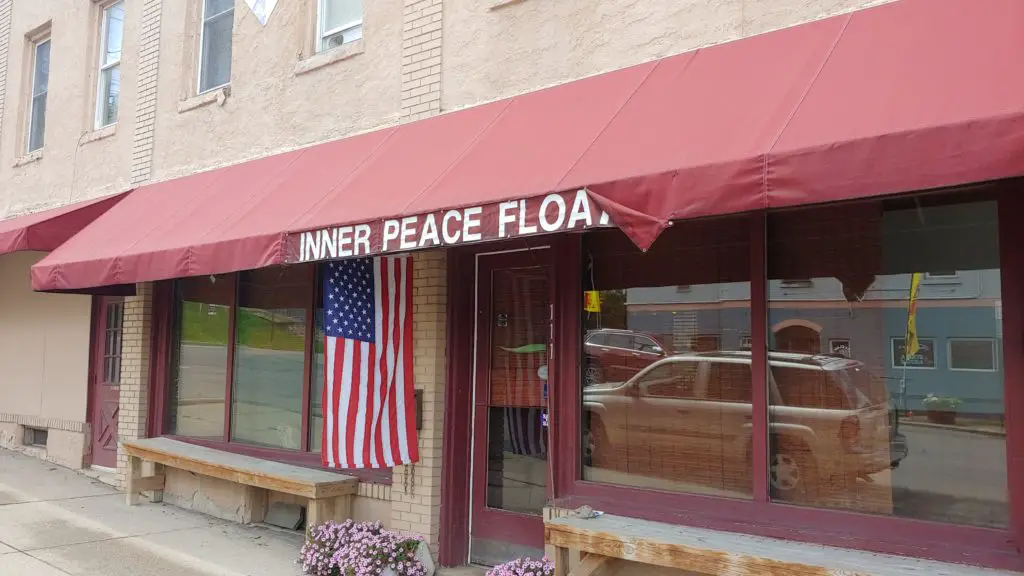Wakins Glen may be known for high-speed racing, but the village at the southern end of Seneca Lake also offers a great way to slow way down.
In fact, I recently visited Inner Peace Floats to do absolutely nothing.
Instead, I let myself be buoyed by a huge tub full of concentrated salt water in a relaxation method called floating.

Clayton at the front desk humbly claims that he’s no special expert on floating. Instead it was just one visit to a floating business in Rochester that enthralled him and family members enough to decide they wanted to bring this experience closer to home and their community. And in 2016, that’s exactly what they did.
INNER PEACE FLOATS INFO
111 W 4th St
Watkins Glen, NY 14891
Phone: (607) 535-6287
Parking: 2-hour street parking in front of the business
Hours: 9 AM to 7 PM daily
Website: https://innerpeacefloats.com
Pricing: First session $65 for 60 minutes or $75 for 90 minutes. All subsequent sessions of any length cost $55.
Current as of 7/2021. Please check with the business for up-to-date information.
What is floating?
Floating has been around since the 1950s, when neuroscientist John C. Lilly experimented with dark, soundproof tanks to create the experience of sensory deprivation.
In the meantime many more people have discovered the meditative experience as a way to find mental and physical relaxation.
Float tanks come in different shapes and sizes, including casket-shaped boxes that sound like the thing of nightmares to claustrophobic me. That’s not what you’ll find at Inner Peace Floats, though. Instead, they have two side-by-side, soundproof rooms with separate floating areas that you can stand up in.
The tubs are filled with 250 gallons of water into which 800 to 1000 pounds of Epsom salt have been dissolved. (That’s magnesium sulfate, the same stuff you might put in your own bathtub.)
Both the water and the surrounding air are held at 93 to 95 degrees Fahrenheit to feel neither too warm or too cold.
Why float?
Just like the Dead Sea, the brine makes your body float into weightlessness and lets your mind relax into daydreams, meditation or even sleep.
Possible benefits include reduced anxiety, stress, and chronic pain; better sleep; increased concentration and creativity; and faster physical recovery after athletic training.
“Most people come out and say, ‘I can’t wait to get in again,'” Clayton tells me. “Just seeing people walk out the door, you can detect the transformation, the tension is gone, they’re calm, they’re just happier.”
Guest comments written on the bathroom walls — encouraged with a basket of markers — attest to that.

Floating at Inner Peace Floats
Clayton really helped set the tone for my recent visit to Inner Peace Floats. He radiates a positive energy that lets you know he really cares about helping you have a good and relaxing floating session.
On the phone, he told me not to worry about arriving exactly on the hour for my appointment time. That turned out to be really helpful as I otherwise would have rushed in from a previous meeting.
The business can be this flexible because they currently (during COVID) schedule only six visitors per day to give everyone the feeling they’ve got the place to themselves and to leave plenty of time for cleaning, which includes a UV sanitation system with multiple filters.
Clayton showed me all the features of the flotation room: There’s a little changing area with hooks and a bench, a shower for washing off before you head into the salt water and especially for afterwards, when you’ll want to wash all the salt from your skin and hair. (Inner Peace Floats provides some delicious-smelling, high-quality shower products, including some sourced from the local Finger Lakes Soap Company.)
The floating chamber has a few buttons on the wall: one for an intercom directly to the front desk, another to regulate the sound if you’d like to listen to music, and a white button to turn on and off a colorful light in the corner.
That light can be really reassuring as you transition to a completely dark environment. I get claustrophobic pretty easily, but these rooms give you lots of control and an easy way out (the shower area has a motion-sensor light), so I was able to get really comfortable.

The actual floating area is like an oversized, flat white bathtub (7′ x 5′) with a foot of slightly slick-feeling water in it and a sloped ceiling above. You can stand up at the taller end. (Get in carefully, the bottom can feel slippery.
You can support your head with a small floating pillow or sink a little further into the water — my preference because I don’t want anything distract from the sensory deprivation. Because of the water’s buoyancy you’re in no danger of having your face submerged.
For the first few minutes, I felt fidgety and a little uncomfortable with my elbows floating up weirdly by my side. I kept bumping into the sides with my hands or feet. But as I started to relax, I stayed pretty stationary. Ten minutes in, my fingers started to tingle, but luckily that passed.
And then, suddenly, I realized I was supremely relaxed. I started to drift off into a timeless zone — and maybe occasionally to sleep. It felt so good!
At some point, I just felt done (or “complete,” as we may say in yoga) and started moving about and eventually left the tub. You’ll know it’s the official end of your session when a white light comes on.
I felt the pleasant effects of my float for the rest of the day. My body and mind were both more relaxed. I was also grateful to have made the time for myself. I’m a strong believer in putting your own oxygen mask on first — because a) you deserve it, and b) it makes you a better human and parent — and that’s exactly what this was.

Floating tips
To get the most out of your floating experience, you may want to consider the following:
- Make sure your skin is in healthy condition, without cuts, scrapes or burns. The Epsom salt can sting. (And wait at least 10 weeks after you’ve gotten a new tattoo to avoid pain and fading.)
- Ideally you want to avoid caffeine 4 hours before your float. That way you can more easily sink into the full relaxation.
- It’s OK to have food before, but it’s better to save big meals for afterward.
- Bring a water bottle, which you can refill at IPF, and stay hydrated.
- Avoid getting water in your eyes (it stings; there’s a wash cloth to wipe your face) or mouth (it’s very bitter).
- Give yourself a good amount of time to arrive and plan at least half an hour to ease out of the experience, take a shower and leave. You don’t want to squander all of that delicious relaxation by rushing off to your next appointment!
- If you have any medical concerns or questions, speak to your doctor before booking your floating session.
Can you float with kids?
Clayton says younger visitors are welcome. He’s had someone as young as 8 years old come in. He just asks that anyone under 18 have a guardian in the building. It’s also possible to float side-by-side with your kid.
Personally, for the time being I’m using floating as a great get-away activity, strictly sans kids. It’s also really nice for a date, which is how I first learned about it (Andrew took me to IPF for Valentine’s Day a few years ago).
Have you floated before? How was it? Do you have any tips? Or did you just get curious? Let us know in the comments below!
PIN this post for later:









 Is a Lifetime Empire Pass Worth it?
Is a Lifetime Empire Pass Worth it?
Leave a Reply